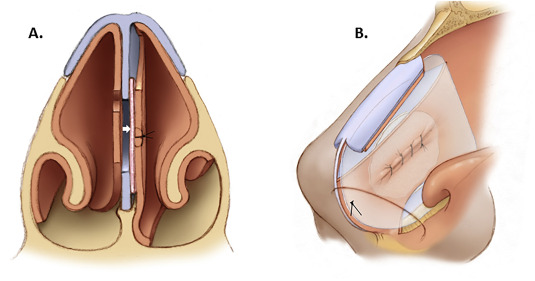Septum Perforation in Turkey Surgery : The nose is one of the most important parts of our respiratory system. It has important tasks such as regulating airflow, warming the air, humidifying the air, and filtering germs and dust. The structure that divides the nasal cavity into two and regulates the air passing through the nostrils is called the “septum”. Septum perforation is a condition where a hole forms anywhere in this structure, i.e., in the middle wall. This hole can affect nasal functions and cause negative effects on both health and quality of life.
Why Does Septum Perforation (Hole in the Nose) Occur?
There are many different causes. Often, multiple factors can trigger this condition. Here are the most common causes:
Nasal Surgeries
The risk of a hole inside the nose is high in people who have had nasal surgery in the past. The septum can be unintentionally damaged during rhinoplasty, deviated septum, or sinus surgeries. Tissues that do not heal properly after surgery can turn into perforation over time.
Prolonged Nasal Spray Use
Sprays used to relieve nasal congestion can damage the nasal mucosa when used for long periods without control. This damage can lead to hole formation in the septum. When nasal sprays are not used correctly, the tissues inside the nose dry out and thin.
Exposure to Chemicals
The risk of perforation increases in people working in environments with chemicals or intensely exposed to environmental pollution. Chemicals can damage the nasal mucosa, causing tissue weakening.
Facial and Nasal Trauma
Accidents, fights, or impacts received during sports can damage the septum. Especially a hard blow to the nose can lead to cracks in the septum or subsequent hole formation.
Drug Use
Taking substances like cocaine and ketamine through the nose destroys the sensitive tissues inside the nose. This situation can cause hole formation in the septum over time. Cocaine, in particular, blocks blood flow in the nasal mucosa, leading to tissue death.
Infections
Infections inside the nose, if left untreated, can cause serious damage. Especially fungal infections or chronic bacterial infections lay the groundwork for hole formation inside the nose.
Smoking
Smoking dries out the nasal mucosa and prevents healing of tissues inside the nose. This situation can cause weakening of the septum and hole formation.
Autoimmune Diseases and Genetic Factors
Some genetic diseases or autoimmune disorders can weaken nasal tissues. This condition can be frequently seen especially in diseases affecting the immune system.
Septum Perforation Symptoms
It can show different symptoms depending on the hole size and location. Perforations can cause various discomforts by converting laminar airflow inside the nose into turbulence. The most common symptoms include nasal itching, nasal congestion, nosebleeds, crusting, foul-smelling nasal discharge, headache, postnasal drip, cartilage inflammation, and whistling sound when breathing. The whistling sound when breathing is generally thought to originate from perforations in the anterior part of the nose. Rarely, dropping of the nasal tip and infections related to perforation can also be seen. While some people may not experience any symptoms, others may experience serious discomfort. Here are the most common symptoms:
- Nasal Dryness and Crusting:
The hole inside the nose disrupts airflow, causing the nasal mucosa to dry out. This dryness creates crusting and a feeling of discomfort. - Nosebleeds:
The perforation area is usually sensitive and nosebleeds are frequently seen. - Whistling Sound When Breathing:
Especially holes located in the anterior part of the septum can cause a whistling sound when breathing in and out. - Headache and Postnasal Drip:
Airflow disturbance inside the nose can affect the sinuses, leading to headaches and postnasal drip. - Foul-Smelling Discharge:
In the presence of infection, a foul-smelling discharge may come from the nose. - Aesthetic Problems:
In advanced perforations, aesthetic deformities such as collapse in the nasal bridge or drooping of the nasal tip can be seen as the nasal support is disrupted.
How Is It Diagnosed?
Diagnosis is usually made by an ear, nose, and throat (ENT) specialist through nasal endoscopy (examination with cameras). Thanks to this painless and short endoscopic examination, even perforations in the back of the nasal septum can be easily detected and a definitive diagnosis can be made. It can also be seen in computed tomography and magnetic resonance imaging taken for other reasons. Before repair, computed tomography examination of the paranasal sinuses may be recommended for some patients, though not all, to evaluate the presence of accompanying paranasal sinus disease.

Septum Perforation Repair and Treatment Methods
The treatment of septum perforation varies depending on the hole size, hole location, severity of symptoms, and the patient’s general health condition. For perforations that do not cause any complaints in patients, no treatment is needed, while in symptomatic cases, medical methods such as nasal irrigation and humidification are initially applied. Although these applied methods may not completely eliminate the patient’s complaints, they can provide relief for a while. However, increasing complaints may make surgical interventions necessary.
Who Is at Risk?
Septum perforation is more common especially in these groups:
- Those who have previously undergone nasal surgery,
- Those exposed to trauma,
- Long-term use of nasal sprays,
- Cocaine users,
- Those with chronic sinusitis or infection.
It is important for these risk groups to be monitored with regular ENT examinations.
Additional information: Depending on the sensitivity of nasal tissues, rarely in some patients, immune system diseases (such as autoimmune diseases like Wegener’s granulomatosis, sarcoidosis, or lupus) can also lead to perforation. Similarly, in industrial workers exposed to heavy metal dusts (nickel, chromium, etc.) or chemical gases, thinning and hole development in the septum can be seen over time.
Surgical Treatment
Treatment of perforations in the septum that create symptoms and reduce quality of life is generally performed using surgical methods. The success of the operation performed is mostly directly proportional to the size of the hole, the location of the hole in the septum, and the remaining cartilage support. To obtain permanent solutions, it is necessary to act appropriately according to the cause, size of the perforation, and bone and cartilage tissue around the perforation. The surgeon will achieve the most successful result as a result of examinations performed on the perforation. In this case, the surgeon’s knowledge and experience will be involved.
Nasal septum perforation is a fairly common pathology, and its successful treatment still poses a significant challenge. Surgical closure of the perforation is a complex process, and there are many records of different surgical techniques in this field in the existing literature. Most of the various surgical techniques performed to date have been unsuccessful. The number of surgeons interested in these operations is also quite limited. For this reason, patients with perforation complaints sometimes remain undecided about surgical intervention.
Special Technique in Septum Perforation Surgery
What is Prof. Dr. Gediz Murat Serin’s difference?
- Dr. Gediz Murat Serin applies a special surgical method he developed to achieve more successful and permanent results in perforation surgeries. This technique has made an important contribution to the medical field by being published in the literature and has received positive feedback from his patients. The method involves a surgical intervention where the perforation is repaired using a membrane taken from the patient’s leg.
- Considering the low success rates of existing methods, Serin prefers to work with membrane tissue taken from the outer side of the upper leg to close the hole inside the nose. The hole is closed with closed (endoscopic) surgery.
- However, since some patients require intervention outside the nose or because patients have insufficient cartilage support inside the nose, surgery is performed with open technique using rib cartilage and this cartilage membrane. That is, both the aesthetics of the nose and the hole inside the nose are closed.
- Whether done open or closed, healthy tissues inside the nose are slid over the hole and a second support is made to the perforation covered with membrane.
- Thanks to these techniques, he has managed to raise the success rate of closing the hole in the septum above 90%. The method offers an effective and promising solution for patients experiencing perforation problems.
- These surgeries are serious operations that require care and sensitivity. It is of great importance for patients to trust their surgeons, have detailed information about the process, and actively participate in the process, both to meet their expectations and to increase their motivation.
📌 What Happens If Septum Perforation Is Not Treated?
If septum perforation is not treated, it can lead to serious health problems over time. Symptoms such as dryness, crusting, chronic bleeding inside the nose and whistling sound when breathing increase, reducing the patient’s quality of life. As the hole widens, collapse in nasal structure (saddle nose deformity) and aesthetic deformities may also occur. Additionally, in the long term, chronic infections, sinus problems, and upper respiratory tract diseases may develop. If early intervention is not made, the chance of surgical success also decreases. Therefore, consulting an ENT specialist is vital.
🔍 You can visit our contact page for more information.
Things to Consider After Surgery
If present, the bandage and casts outside the nose are removed on the seventh day after surgery, but the silicone stent inside the nose is removed in the third week after surgery. It is important for patients to be careful during the recovery process after surgical treatment. Here are the points to be considered:
- Protect your nose from impacts.
- Do not smoke and stay away from irritating substances.
- Pay attention to nasal cleaning and humidification.
- Use other medications recommended by your doctor regularly.
Conclusion
It is a serious condition that can negatively affect quality of life. However, with proper diagnosis and treatment methods, this problem can be completely eliminated. Although surgical success rates are quite high, there is no one hundred percent rate. If you are experiencing symptoms such as nasal congestion, bleeding, or whistling sound when breathing, it is important to consult a specialist. Remember, paying attention to your nasal health is of critical importance for your overall health.
Does septum perforation close on its own?
This is one of the first questions that comes to patients’ minds. Scientifically, septum perforation does not close on its own. Small holes can remain the same for a long time but never completely heal and disappear.
Additional information: Some patients may think “the hole closed” because they think their complaints have decreased, especially in small perforations. However, when endoscopic examination is performed, the perforation is still seen to be present. So, reduction of symptoms should not be confused with hole closure.
Does septum perforation grow?
Many patients worry “will the hole grow?” Yes, there is a possibility of growth. Especially constant dryness inside the nose, trauma, chronic infection, and smoking can cause the perforation to grow.
Additional information: The risk of growth is especially higher in perforations over 1 cm. Additionally, in women during pregnancy, changes made in the nasal mucosa by increasing estrogen and progesterone hormones can lead to easier drying and widening of existing perforations. Therefore, regular use of nasal moisturizers during pregnancy becomes even more important.
What complaints does septum perforation cause?
Nasal congestion, sleep disorders, whistling sound when breathing, recurrent nosebleeds, intense dryness and crusting, pressure sensation in the nose, and in advanced cases, collapse of the nasal tip can be seen.
Additional information: In long-term septum perforations, a decrease in sense of smell can also develop due to chronic infection. Additionally, some patients experience serious discomfort in social settings due to the sound coming from breathing through the nose and are also psychologically affected.
Is treatment possible without surgery?
Non-surgical methods provide temporary relief but are not a permanent solution. Moisturizing sprays, ointments, or septal buttons can be used. However, the definitive treatment is surgery.
Additional information: In recent years, some centers have been making attempts to close small perforations with “biological adhesives” or tissue engineering products. However, these methods have not yet become standard treatment.
Is septum perforation surgery difficult?
The difficulty of the surgery varies according to the hole size, location, and condition of surrounding tissues. While small perforations are easier to close, surgery for large perforations can be more complex.
Additional information: During surgery, the surgeon needs to preserve nasal integrity both functionally and aesthetically. For this reason, this operation must be performed by experienced ENT surgeons. Success rates are quite high in experienced hands.
Will the hole open again after surgery?
This risk is quite low in surgeries performed with the correct technique. However, smoking, trauma, cocaine use, and not following care recommendations negatively affect success.
Additional information: The first 6 months after surgery is the most critical period. During this process, the patient needs to maintain nasal moisture, not miss doctor check-ups, and absolutely not use cocaine or smoke.
What is the recovery process after surgery?
In the first days, there may be slight bleeding and crusting. Regular dressing and moisturizing speed up healing. Most patients start breathing comfortably within 3-4 weeks.
Additional information: In large perforation surgeries, the complete healing process can take 3-6 months. Being patient during this process and following the doctor’s recommendations is very important.
Frequently Asked Questions
How is septum perforation detected?
It is noticed by shortness of breath, whistling sound in the nose, frequent nosebleeds, and crusting.
Why does a hole occur in the septum?
It can occur due to trauma, nasal surgeries, cocaine use, infection, or long-term spray use.
What happens if the hole between the nostrils doesn’t close?
The hole can grow, nasal shape can be distorted, and breathing can become difficult.
Does a septum hole close on its own?
Small perforations rarely can close, surgery is usually required.
Will the nose be perforated again after surgery?
The probability is low, but trauma or incorrect care can lead to perforation again.
How long is the recovery time after surgery?
Complete recovery usually occurs within 1-3 months.
What happens if a septum hole is not treated?
Symptoms intensify, the hole grows, and the nasal shape can be damaged.
Does a septum hole heal without surgery?
No, the permanent solution is usually surgical. Sprays and moisturizers only provide temporary relief.
What Is the Cost of Septum Perforation Surgery?
The price of surgery can vary depending on many factors. Especially factors such as the size and location of the perforation, which surgical technique will be applied, graft (cartilage, fascia, etc.) need, the equipment of the hospital where the surgery will be performed, and the experience of the surgeon performing the surgery play a determining role on the cost. Additionally, whether the surgery will be done for purely functional purposes or with aesthetic touches can also affect the total cost.
Price information is usually given specifically to the patient after a detailed examination and evaluation. Therefore, it is recommended that people considering surgery consult an ear, nose, and throat specialist experienced in this field for a comprehensive evaluation. Perforation surgeries offer an important solution especially for patients who have been experiencing nasal discomfort for a long time and whose quality of life is affected by this condition.
Instagram : prof.dr.gedizmuratserin
Author: Prof Dr. Gediz Murat Serin



